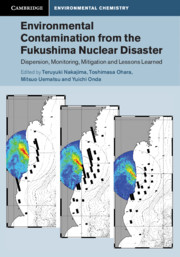 Environmental Contamination from the Fukushima Nuclear Disaster
Environmental Contamination from the Fukushima Nuclear Disaster Book contents
- Environmental Contamination from the Fukushima Nuclear Disaster
- Cambridge Environmental Chemistry Series
- Environmental Contamination from the Fukushima Nuclear Disaster
- Copyright page
- Contents
- Contributors
- Preface
- Acknowledgements
- Part I Transport of Radioactive Materials in the Environment
- 1 Introduction
- 2 Estimation of Environmental Releases of Radioactive Materials
- 3 Diffusion in the Atmosphere
- 4 Global Transport of Radioactive Materials
- 5 Ocean Transport of Radioactive Materials
- 6 Diffusion and Deposition of Radioactive Materials in the Terrestrial Environment
- Part II Development and Future Issues for the Infrastructure of Disaster Prevention
- Part III Lessons and Future Issues from the Fukushima Accident
- Glossary
- Names of Locations
- Index
- References
1 - Introduction
Basic Concepts Regarding the Fukushima Accident and Radiation and Radioactivity
from Part I - Transport of Radioactive Materials in the Environment
Published online by Cambridge University Press: 16 August 2019
- Environmental Contamination from the Fukushima Nuclear Disaster
- Cambridge Environmental Chemistry Series
- Environmental Contamination from the Fukushima Nuclear Disaster
- Copyright page
- Contents
- Contributors
- Preface
- Acknowledgements
- Part I Transport of Radioactive Materials in the Environment
- 1 Introduction
- 2 Estimation of Environmental Releases of Radioactive Materials
- 3 Diffusion in the Atmosphere
- 4 Global Transport of Radioactive Materials
- 5 Ocean Transport of Radioactive Materials
- 6 Diffusion and Deposition of Radioactive Materials in the Terrestrial Environment
- Part II Development and Future Issues for the Infrastructure of Disaster Prevention
- Part III Lessons and Future Issues from the Fukushima Accident
- Glossary
- Names of Locations
- Index
- References
Summary
The accident of the Fukushima Daiichi (First) Nuclear Power Station (FDNPS) of the Tokyo Electric Power Company (hereafter, Fukushima accident) transpired after the Tohoku Region Pacific Coast Earthquake occurred in March 2011. Table 1.1 summarises the main events of the accident. After the earthquake occurred at 14:46 on 11 March 2011, tsunami waves of 13 m in height arrived at the FDNPS (TEPCO, 2011); the diesel power engine stopped at 15:41. Due to this electricity loss, the nuclear reaction became uncontrollable. The Fukushima Daini (Second) Power Station was able to make a controlled stop for cooling even after the intrusion of seawater from a tsunami wave with a height of 9 m. The estimated maximum height in the design of the Daiichi and Daini Power Stations was 5.1 m. In contrast, the estimated maximum tsunami height in the design of the Onagawa Nuclear Power Station of the Tohoku Electric Power Company, which avoided serious damage, was 14.8 m (Matsumoto, 2007).
- Type
- Chapter
- Information
- Environmental Contamination from the Fukushima Nuclear DisasterDispersion, Monitoring, Mitigation and Lessons Learned, pp. 5 - 49Publisher: Cambridge University PressPrint publication year: 2019


